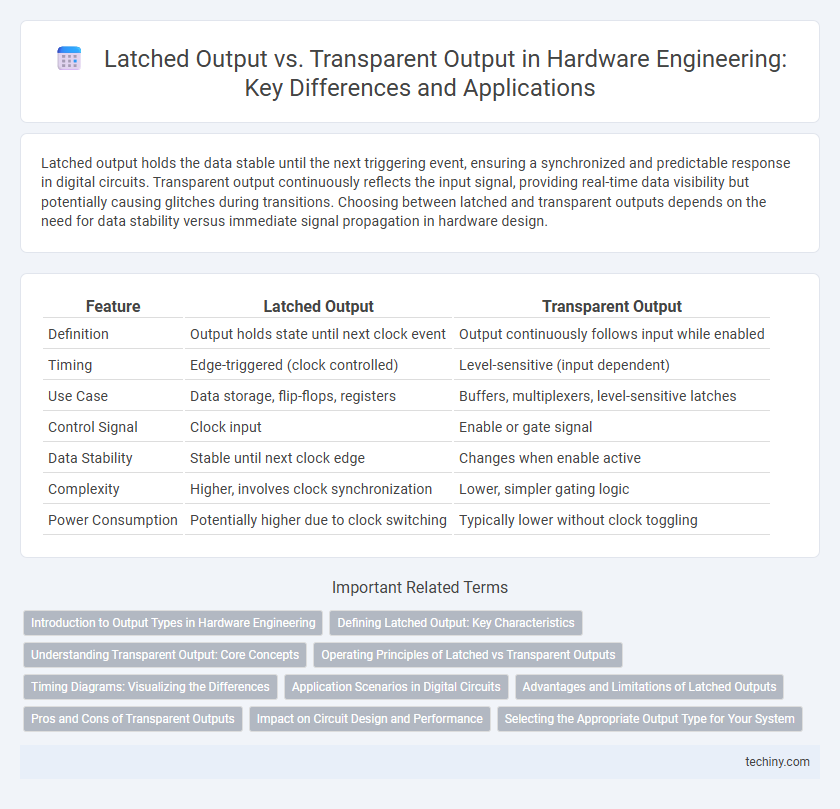Latched output holds the data stable until the next triggering event, ensuring a synchronized and predictable response in digital circuits. Transparent output continuously reflects the input signal, providing real-time data visibility but potentially causing glitches during transitions. Choosing between latched and transparent outputs depends on the need for data stability versus immediate signal propagation in hardware design.
Table of Comparison
| Feature | Latched Output | Transparent Output |
|---|---|---|
| Definition | Output holds state until next clock event | Output continuously follows input while enabled |
| Timing | Edge-triggered (clock controlled) | Level-sensitive (input dependent) |
| Use Case | Data storage, flip-flops, registers | Buffers, multiplexers, level-sensitive latches |
| Control Signal | Clock input | Enable or gate signal |
| Data Stability | Stable until next clock edge | Changes when enable active |
| Complexity | Higher, involves clock synchronization | Lower, simpler gating logic |
| Power Consumption | Potentially higher due to clock switching | Typically lower without clock toggling |
Introduction to Output Types in Hardware Engineering
Latched outputs maintain a stable signal state by storing data until triggered by a clock edge, ensuring synchronized data flow in sequential circuits. Transparent outputs continuously reflect input changes, providing real-time data visibility without intermediate storage. Choosing between latched and transparent outputs depends on design requirements for timing control and signal stability in hardware systems.
Defining Latched Output: Key Characteristics
A latched output in hardware engineering holds its state stable until explicitly changed, characterized by its ability to store data by being triggered on a control signal like a clock edge. Unlike transparent outputs that continuously reflect input changes, latched outputs maintain their value regardless of input fluctuations, providing reliable data storage and synchronization in digital circuits. This property is crucial for designing sequential logic components such as flip-flops and registers, ensuring predictable timing and stable data retention.
Understanding Transparent Output: Core Concepts
Transparent output in hardware engineering refers to a type of data latch where the output directly follows the input signal whenever the latch enable is active, allowing continuous data flow. This behavior contrasts with latched output, which holds the last input state when the latch enable signal is inactive, ensuring state retention. Understanding that transparent latches serve as level-sensitive devices helps optimize timing analysis and data synchronization in digital circuit design.
Operating Principles of Latched vs Transparent Outputs
Latched outputs maintain their state until triggered by a clock or control signal, enabling stable data storage and synchronization in digital circuits. Transparent outputs continuously reflect input changes as long as the enable signal is active, allowing real-time data flow but lacking inherent storage capability. Understanding these operating principles is crucial for designing reliable hardware systems with precise timing control and data integrity.
Timing Diagrams: Visualizing the Differences
Timing diagrams for latched outputs feature data held stable during the latch's inactive phase, highlighting the storage function in hardware design. Transparent output timing diagrams display immediate data reflection while the latch is active, demonstrating real-time data flow. Comparing these visual patterns clarifies the timing relationship between input signals and output responses in digital circuit analysis.
Application Scenarios in Digital Circuits
Latched outputs are ideal in digital circuits requiring data synchronization and stable storage during clock cycles, commonly used in register designs and state machines to hold values until the next triggering event. Transparent outputs suit applications needing continuous real-time data propagation, such as multiplexers and combinational logic where input changes must immediately reflect on outputs. The choice between latched and transparent outputs depends on timing control requirements and the necessity for stable versus dynamic signal representation in hardware designs.
Advantages and Limitations of Latched Outputs
Latched outputs provide stable data retention by maintaining the output state even when the input changes, ensuring reliability in synchronous circuits and reducing timing hazards. They enable precise control over data transfer timing, which is crucial for clocked operations in hardware systems. However, latched outputs can introduce complexity in design and increase susceptibility to glitches if the latch enable signal is not properly managed.
Pros and Cons of Transparent Outputs
Transparent outputs allow continuous data propagation while the enable signal is active, offering simpler timing analysis and faster response in combinational logic paths. However, they can introduce glitches and unintended data changes due to their sensitivity to input transitions, making them less stable for synchronous designs. Transparent latches may complicate timing closure in complex circuits, increasing the risk of race conditions compared to latched outputs that hold data until explicitly updated.
Impact on Circuit Design and Performance
Latched output ensures signal stability by capturing data only on clock edges, which reduces timing errors and enhances noise immunity in sequential circuits. Transparent output continuously reflects the input state, enabling faster data propagation but increasing susceptibility to glitches and timing hazards. Choosing between latched and transparent outputs significantly influences clock design complexity, power consumption, and overall reliability in hardware engineering applications.
Selecting the Appropriate Output Type for Your System
Latched output holds its state until explicitly changed, providing stability and preventing glitches in sequential logic applications, while transparent output continuously reflects input changes, ideal for real-time data monitoring. Selecting the appropriate output type depends on system requirements such as timing constraints, data integrity, and signal synchronization needs. For applications requiring precise control and noise immunity, latched outputs are preferred, whereas transparent outputs suit scenarios demanding immediate responsiveness.
Latched output vs Transparent output Infographic

 techiny.com
techiny.com